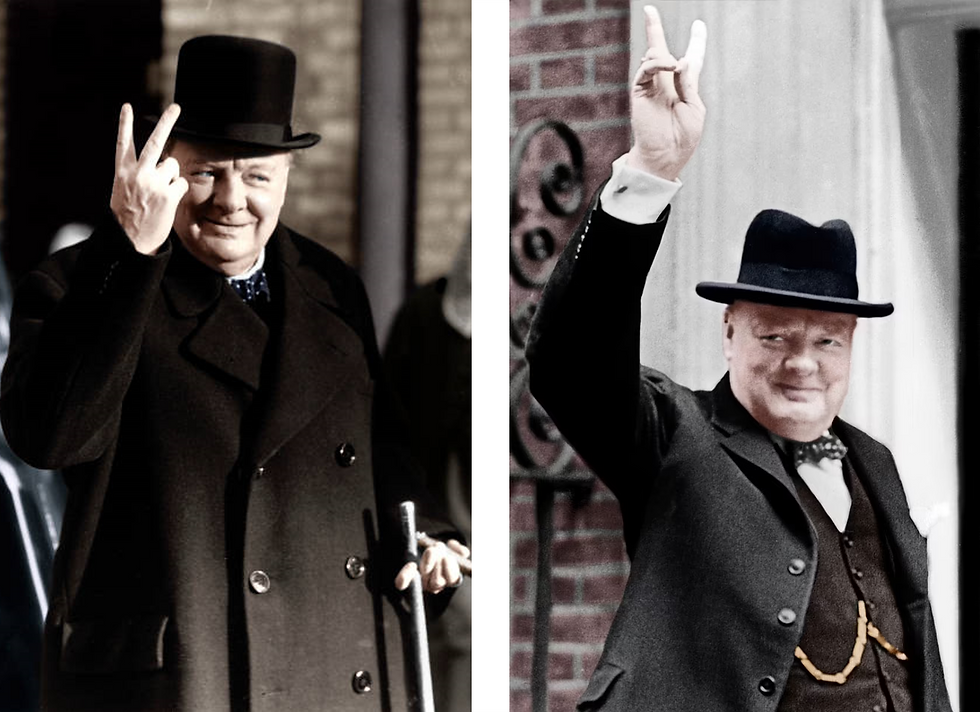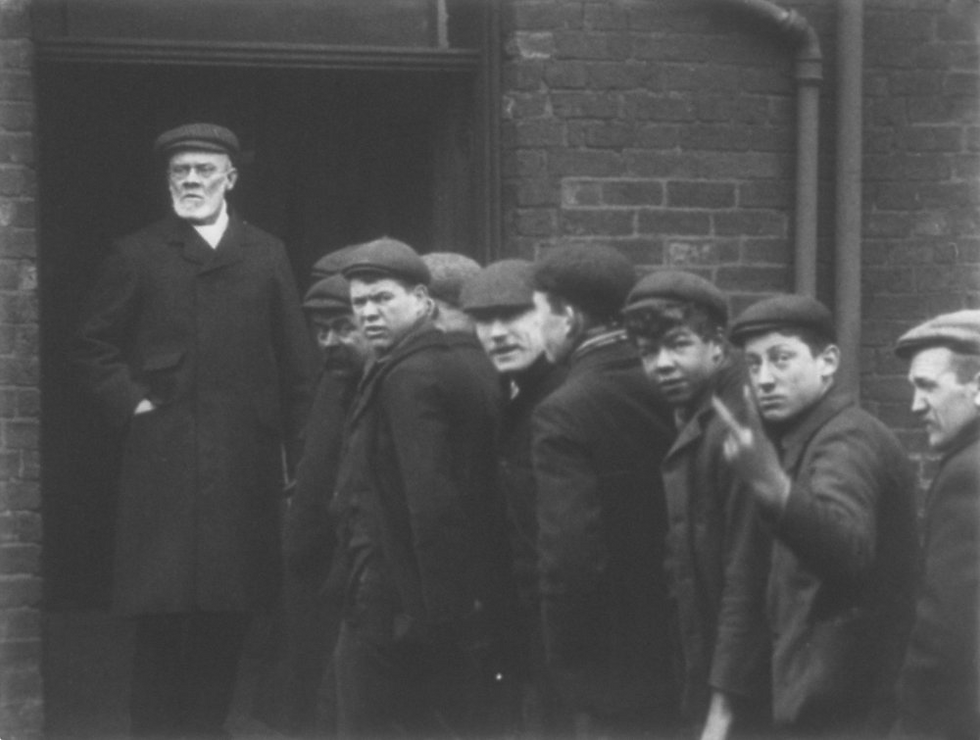
Despite the best efforts of historians, the internet is still awash with misconceptions about the Middle Ages. Many of these ideas were the product of Victorian writers and historians reflecting Medieval life through the lens of their own society, as was done by antiquarians before and by historians since. However, after more than a century in popular culture, and taught in schools, these sometimes broad, sweeping assertions remain deeply rooted in everyday consciousness, especially when repeatedly reinforced online, in social media, on television and in the movies. Before addressing one such notion, it is worth remembering that the Mediæval period lasted roughly 1,000 years during which peoples’ lives and experiences varied according to time, place and circumstance. So, with that in mind, did the two-finger salute or V-sign originate with Mediæval English and Welsh archers?
Two-finger salute The infamous two-finger salute or V-sign is considered either a symbol of defiance and victory, or an insulting gesture. Most famously, in Britain at least, the V-sign was adopted by Winston Churchill during and throughout World War II but, as can be seen below left, in 1942 he was photographed using the insulting form. Perhaps he did that deliberately or perhaps, as depicted in one scene in the 2017 film “Darkest Hour”, he unknowingly made a mistake until it was pointed out that the first version was considered rude. Regardless, Churchill was soon to make the “V for victory” sign a morale boosting and iconic symbol of defiance (below right).

The same gesture was mentioned in a previous post concerning the origin of the phrase “by hook or by crook” when considering the imposition of Forest Laws by Norman and later kings. One of the penalties for hunting with a bow in England’s royal forests is said to have been the severing of the first two fingers of the right hand so the poacher could no longer draw his bow. This is probably an apocryphal story, however, in much the same way that the two-fingered salute or V sign reputedly originated from a gesture made by English longbowmen fighting at the Battle of Agincourt (25 October 1415). The two are seemingly linked as the latter urban myth follows similar logic in that it claims English archers captured by the French had their index and middle fingers cut off so that they could no longer draw their bows. The insinuation is that the two-fingered V-sign was used as both an insult and a display of defiance towards the French. But there are a couple of problems with this tale.

Firstly, why go to the bother of only removing a couple of fingers when it would be far faster and more effective to cut off the hand or kill the captured archer. Not that the killing of prisoners was condoned by the rules of war but a prisoner’s chances of survival after capture were not always great. Still, losing two or three fingers would not necessarily render the man ineffective. Even disabled in this manner they might still be useful in battle, perhaps wielding a different weapon like a spear, or employed in logistic roles. It is equally unlikely that archers were earmarked for special treatment since most were lowborn commoners with no real value to the French. They simply did not merit ransoming so taking them prisoner would be literally worthless.
Secondly, and most importantly, there are no written historical primary sources supporting the claim. The contemporary 15th-century chronicler Jean de Wavrin (or Jehan de Waurin) did report King Henry V’s pre-battle speech in which he told his assembled men:
“…how the French were boasting that they would cut off three fingers of the right hand of all the archers that should be taken prisoners to the end that neither man nor horse should ever again be killed with their arrows.”

Note that the threat was to sever three fingers not two which does make the connection to the later V-sign somewhat dubious. Yet Wavrin was present at the battle, albeit on the French side so the chances he heard and accurately recorded the speech himself is equally debateable. Although a valuable source, albeit writing more than twenty years after the battle, Wavrin most likely invented Henry’s words to appease readers familiar with such constructs from earlier, classical authors. Most importantly, he and those others present, such as heralds whose job it was to record the battle, do not report anyone sticking one, two or three fingers in the air. Nor do Wavrin or any other contemporary author report that the threat was ever carried out after Agincourt or any other battle. Furthermore, the surviving sources from the Hundred Years’ War period are surprisingly silent concerning a gesture of defiance.
Desmond Morris [1] identified the earliest record of the V-sign as an insult in the 16th-century writings of François Rabelais. In his “Gargantua and Pantagruel” series of books appears the character Panurge, an exceedingly crafty knave, libertine and coward, who is described as carrying on a gestural “duel”. Rabelais writes that after making an explicit copulation sign, Panurge then:
“…stretched out the forefinger, and middle finger or medical of his right hand, holding them asunder as much as he could, and thrusting them towards Thaumast.”

Clearly something like the V-sign was known in the 1550s, and it is interesting that Rabelais has an Englishman making the gesture. Even so, the gesture disappears from the historical record not re-appearing until the early 20th-century in footage filmed by Mitchell and Kenyon in 1901 [2]. In the still shown right, men are shown standing in line outside the Parkgate Iron and Steel Company in Rotherham. One of them, clearly not too pleased about being filmed, presents a clear two-finger salute to the camera. So, we have a description of a possible insulting gesture in the 16th-century that seemingly disappears and avoids being depicted or described for the best part of 400 years. Sometime thereafter, perhaps in an attempt to explain its origins, a jingoistic tale about the “reviled” French threatening to capture and mutilate “plucky” English archers at Agincourt surfaces. Yet, there is no evidence to connect the two-finger salute to the battle, and little else to establish the V-sign’s origin.
Bon appétit!
Reference:
Morris, D., (1979), “Gestures: their origins and distribution”, London: Jonathan Cape, p.228.
Endnotes:
1. Desmond John Morris FLS hon. caus. (born 24 January 1928) is an English zoologist, ethologist and surrealist painter, as well as a popular author in human sociobiology. He is known for his 1967 book “The Naked Ape”, and for his television programmes such as “Zoo Time”. ▲
2. Sagar Mitchell and James Kenyon founded the firm of Mitchell & Kenyon in 1897. Sagar Jones Mitchell (28 October 1866 – 2 October 1952) was a pioneer of cinematography in Blackburn, Lancashire, England. James Kenyon (26 May 1850 – 6 February 1925) was a businessman and pioneer of cinematography in the same town. ▲

댓글